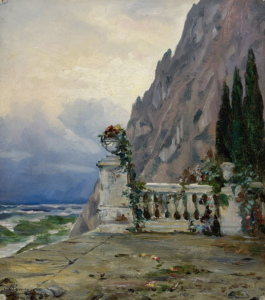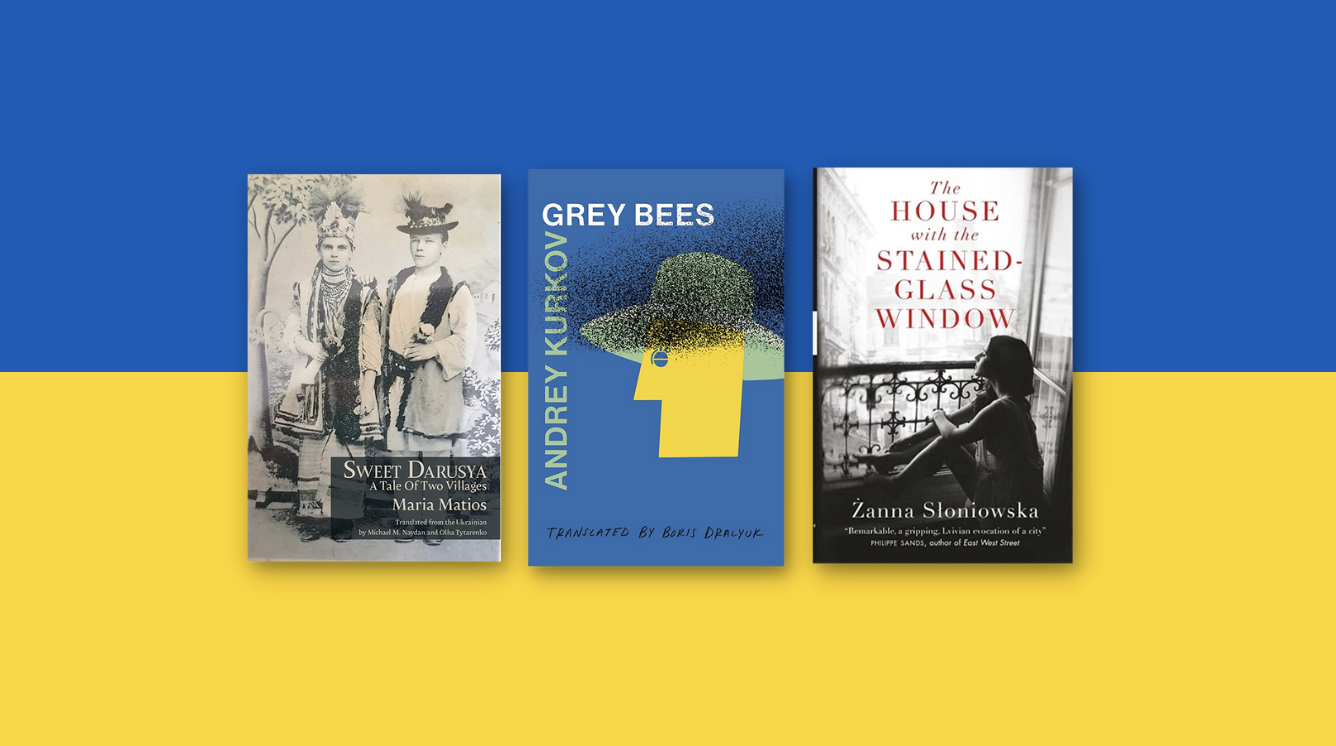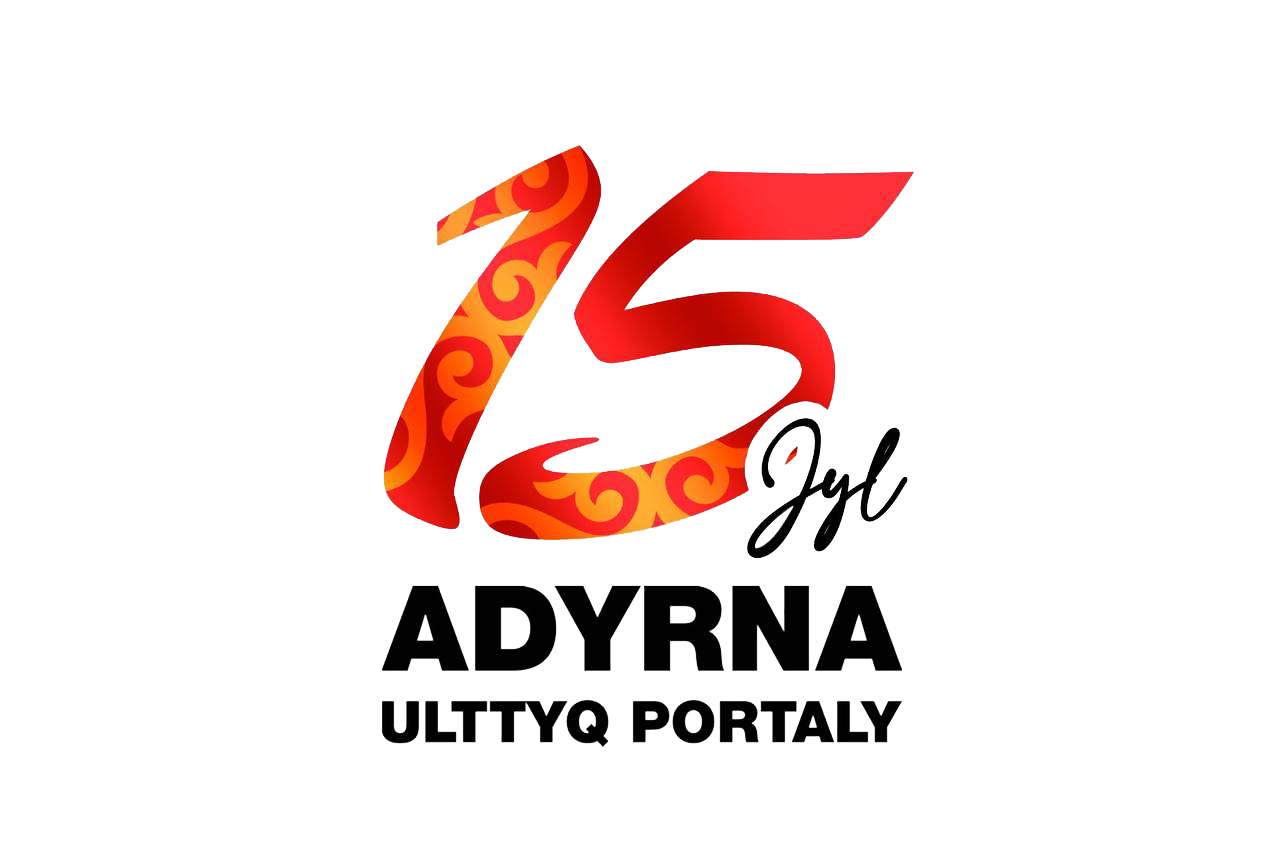When Russia invaded Ukraine one year ago, the region of Sumy, just northeast of Kyiv, came under intense bombardment, endangering the house where Anton Chekhovspent two halcyon summers working on his play The Wood Demon, as well as several short stories. The house had been turned into a museum in 1960 and contained many irreplaceable artifacts, including Chekhov’s medical instruments and a portrait of Chekhov painted by his brother Nikolay.
Chekhov was born in Taganrog on the Sea of Azov, just across the border from Ukraine. His paternal grandmother was Ukrainian, and—according to Chekhov—he spoke Ukrainian as a child. His first major literary breakthrough, the long short story “The Steppe,” was based on his boyhood journeys across the vast Ukrainian steppe to visit his grandparents. It is suffused with the bucolic, unspoiled charm of this fabled land. The story delighted readers and critics in Moscow and St. Petersburg, who seemed to be always dazzled by tales of this land that the Russian Empire was eternally bent on subjugating.
In later years, Chekhov often jokingly referred to himself as a khokhol, a derogatory Russian term for a Ukrainian. His letters from Sumy describe lazy days fishing on Psyol River and exploring the countryside. His enchantment with Ukraine is abundantly clear in his letter to Nikolai Leikindescribing his travels through Ukraine in 1888:I received your second letter, dearest Nikolai Alexandrovich, yesterday, upon returning from Poltava province…. I have been in Lebedyn, Hadyach, Sorochintsy and many places extolled by Gogol. What places they are! I am completely enchanted. I had the good luck to have wonderfully warm weather the whole time, travelled in a comfortable sprung carriage and arrived in Poltava province just when they had started haymaking.
Chekhov was so taken by the region that he eventually began searching for a small estate, planning on permanently relocating there. As he explained to Leikin:
Everything I saw and heard was so new, good and wholesome that throughout the journey I could not dispel the bewitching idea of abandoning literature, which I’m fed up with, settling in some village or other on the banks of the River Psyol and practicing medicine. If I lived on my own, I would stay in Poltava province, as I don’t feel any attachment to Moscow. I would spend my summers in Ukraine and come to lovely St. Petersburg in the winter. Apart from nature, nothing about Ukraine astonishes me more than the feeling of general contentment, people’s good health, and the high level of development of the peasants here, who are clever, devout, musical, sober, morally upright, and always jolly and well-fed.
Chekhov’s strong ties with Ukraine are usually dismissed by Russian critics—and he is not alone. There are many other world-famous writers who rose from the fertile soil of Ukraine, though “official” narratives often obscure these origins.
 Joseph Conrad is remembered as a Polish writer who he went on to become one of the great masters of the English language. But the author of Heart of Darknesswas actually born in a small village near Kyiv, and Ukraine was his home throughout his early years. As an ethnic Pole from Ukraine, Conrad has been exhaustively viewed by critics through his Polish roots, but his Ukrainian heritage and upbringing have gone relatively unnoticed.
Then there is Nicolai Gogol, one of the founding fathers of Russian literature—except that Gogol was actually Ukrainian through and through. He grew up in the Poltava Province in central Ukraine, a native speaker of Ukrainian. His first book, Evenings on a Farm Near Dikanka, was set in the “exotic” locale of the Ukrainian countryside and was hugely successful in Moscow and St. Petersburg, where Russian literary circles were hungry for folk tales with colorful settings. Gogol wrote in Russian at a time when the Ukrainian language was suppressed by Tsarist Russia, and the teaching of Ukrainian in most schools was banned.
And, of course, Isaac Babeland Sholem Aleichem were natives of Ukraine who wrote about the Jewish experience in the thriving, polyglot, multiethnic world of late nineteenth- and early twentieth-century Ukraine. Both Babel’s Odessa Storiesand Aleichem’s Tevye the Dairyman (which became the basis for Fiddler on the Roof) are thoroughly infused with a uniquely Ukrainian ethos.
Joseph Conrad is remembered as a Polish writer who he went on to become one of the great masters of the English language. But the author of Heart of Darknesswas actually born in a small village near Kyiv, and Ukraine was his home throughout his early years. As an ethnic Pole from Ukraine, Conrad has been exhaustively viewed by critics through his Polish roots, but his Ukrainian heritage and upbringing have gone relatively unnoticed.
Then there is Nicolai Gogol, one of the founding fathers of Russian literature—except that Gogol was actually Ukrainian through and through. He grew up in the Poltava Province in central Ukraine, a native speaker of Ukrainian. His first book, Evenings on a Farm Near Dikanka, was set in the “exotic” locale of the Ukrainian countryside and was hugely successful in Moscow and St. Petersburg, where Russian literary circles were hungry for folk tales with colorful settings. Gogol wrote in Russian at a time when the Ukrainian language was suppressed by Tsarist Russia, and the teaching of Ukrainian in most schools was banned.
And, of course, Isaac Babeland Sholem Aleichem were natives of Ukraine who wrote about the Jewish experience in the thriving, polyglot, multiethnic world of late nineteenth- and early twentieth-century Ukraine. Both Babel’s Odessa Storiesand Aleichem’s Tevye the Dairyman (which became the basis for Fiddler on the Roof) are thoroughly infused with a uniquely Ukrainian ethos.

 The list of other great writers from Ukraine goes on and on. Mikhail Bulgakov, whose novel The Master and Margarita is a classic of modern fiction, was born in Kyiv in 1891 and graduated from the University of Kyiv in 1916. Vasily Grossmanwas also born and bred in Ukraine; his novel Life and Fate is one of the greatest war novels ever written. Yet because they are ethnically Russian, Bulgakov and Grossman are usually referred to as Russian writers. (This would be like calling Jack Kerouac a Canadian writer because his ancestry is French-Canadian.) In things literary—as with so many things—Ukraine is the locus of many heated arguments.
The list of other great writers from Ukraine goes on and on. Mikhail Bulgakov, whose novel The Master and Margarita is a classic of modern fiction, was born in Kyiv in 1891 and graduated from the University of Kyiv in 1916. Vasily Grossmanwas also born and bred in Ukraine; his novel Life and Fate is one of the greatest war novels ever written. Yet because they are ethnically Russian, Bulgakov and Grossman are usually referred to as Russian writers. (This would be like calling Jack Kerouac a Canadian writer because his ancestry is French-Canadian.) In things literary—as with so many things—Ukraine is the locus of many heated arguments.
“Ukraine” literally translated means “borderland,” and that accurately describes the history of this troubled, war-torn terrain whose borders have shifted with dizzying rapidity, especially in the twentieth century. From its heyday 1,000 years ago, when Kievan Rus extended from the Baltic to the Black Sea, Ukraine has been occupied, annexed, and chopped up by neighboring countries so often that its cities are a palimpsest of ethnicities, cultures, and languages. In the twentieth century alone, western Ukraine has changed hands between Poland, Romania, the Austro-Hungarian Empire, Germany, and the Soviet Union. Its main city, Lviv, was Lwow when it was part of Poland, Lemberg when it was part of the Austro-Hungarian Empire, and Lvov when it was taken over by the Soviet Union.
As a result, modern Ukrainian literature today is a thriving, heterodox, polyglot scene, especially since the collapse of the Soviet Union and the declaration of Ukrainian independence 30 years ago. But the gnawing question of Ukrainian statehood—so elusive for most of its history—combined with the systematic repression of the Ukrainian language and Ukrainian culture has made some Ukrainians ambivalent about fully embracing the many writers from Ukraine who are not ethnic Ukrainians.Now, at a time when Russia’s brazen and unprovoked invasion of Ukraine threatens not only Ukraine’s independence but also its cultural inheritance and language, there is a new urgency to protect and promote Ukraine’s rich cultural and literary heritage, which is in fact a multilingual and multiethnic tapestry.
*
Three recently translated novels from Ukraine—each one celebrated for revealing the “true” Ukraine—nicely demonstrate the astonishing breadth and depth of contemporary Ukrainian literature: Andrey Kurkov’s Grey Bees (Kurkov lives in Kyiv, is ethnically Russian, and writes in Russian), Żanna Słoniowska’s The House with the Stained-Glass Window(Słoniowska is from Lviv, is ethnically Polish, and writes in Polish), and Maria Matios’s Sweet Darusya (Matios is from Bukovina in southwestern Ukraine, is ethnically Ukrainian, and writes in Ukrainian).Kurkov is no doubt the best known of the three. When his tragicomic masterpiece Death and the Penguin burst on the scene in 1996, it was widely translated, received glowing reviews, and put post-Soviet Ukrainian literature on the map. In 2002, Kurkov followed up with an equally compelling sequel, Penguin Lost, which firmly established his beloved penguin, Misha, as an unlikely symbol of the new Ukraine, occupying a space that seemed made of equal parts of absurdity and compassion.
The serio-comic vein of Kurkov’s early work, as well as his madcap Rabelaisian streak, has greatly mellowed over the years, no doubt due to the many upheavals and conflicts that Ukraine has endured over the past 20 years. In his most recent novel Grey Bees, translated by Boris Dralyuk, the style and tone are much more grounded and introspective. Long, wistful reminiscences and scenes of domestic housekeeping are interspersed with tense battle scenes and confrontations with the military. The acidic, amused sarcasm and irony of Kurkov’s early narrative voice has given way to a deeply humane and sympathetic narrator. The rampant political corruption and bureaucratic dysfunction that once was a topic for bemused laughter and satire have now become elements of a tragedy.Grey Bees is set in the years immediately after Russia annexed Crimea and instigated the conflict in eastern Ukraine in 2014, but before the current full-scale invasion of Ukraine. The “grey” in Grey Bees refers to the gray zone in the east between the Russian-backed separatists and the Ukrainian defenders—front lines that were virtually frozen for eight years, resulting in thousands of casualties. Between these front lines, most people evacuated from towns and cities, but some stayed, like Kurkov’s gruff but loveable protagonist, Sergeyich, a beekeeper completely devoted to his bees.
The novel traces Sergeyich’s peripatetic odyssey across war-torn Ukraine to find a peaceful meadow where his bees can thrive unmolested by mortars or artillery fire. About half the novel recounts his adventures and mishaps on the road. When Sergeyich finally arrives in Crimea searching for his fellow beekeeper, a Crimean Tatar, the full ugliness and horror of the Russian occupation become clear. Through it all, the health and welfare of his bees is Sergeyich’s main concern, and gradually this worry soon becomes the reader’s own. We feel for those bees, root for those bees, feel joy for those bees when they are finally liberated to fly free among wildflowers. In a sense, the bees give Sergeyich’s life a purpose and bring out his best qualities:If it weren’t for the bees, he wouldn’t have gone anywhere…. But bees don’t understand what war is. Bees can’t switch from peace to war and back again, as people do. They must be allowed to perform their main task—the only task in their power—to which they were appointed by nature and by God: collecting and spreading pollen. That’s why he had to go, to drive them out to where it was quiet, where the air was gradually filling with the sweetness of blossoming herbs, where the choir of these herbs would soon be supported by the choir of flowering cherry, apple, apricot and acacia trees.
The bees become an easily transportable microcosm representing all innocent creatures (including humans) whose lives are affected by the violence of war. Sergeyich—gruff, hard-drinking, and disheveled—is rendered almost saintly by his devotion to his bees and to his fellow beekeeper, a Crimean Tatar who was “disappeared” by the Russian occupiers. To put it another way, the bees are Kurkov’s symbolic “penguin” in this novel—a stand-in for Misha the lost penguin now transformed into a colony of tireless workers that humans depend on. And, just as the main task of the penguin novels was rescuing and returning Misha to his native habitat, so, too, with these bees. There is always, it seems, a penguin in Kurkov’s novels even when it’s not a penguin.

Unlike Kurkov’s earlier novels, Grey Bees carries an overt political message, made even clearer by Kurkov’s new foreword to the book written after Russia’s full-scale invasion, in which he excoriates Russia and Vladimir Putin. Żanna Słoniowska’s The House with the Stained-Glass Window, translated by Antonia Lloyd-Jones,couldn’t be more different. It is set in Lviv, on the opposite side of the country from Grey Bees. Unlike Kurkov, Słoniowska does not try to uncover the soul of Ukraine by delving deeply into the hearts of its people. Rather, she focuses on the human-built environment—specifically the city of Lviv—whose streets, architecture, cemeteries, and public spaces tell the story of the manifold peoples and cultures who have made this storied metropolis their home. To do this, she moves backward and forward in time, tracing the lives of four generations of an ethnic Polish family as they endure the privations and horrors of the region’s modern history.
Słoniowska’s unnamed narrator remains an enigma. She’s the daughter of Marianna, a famous opera singer killed during an anti-Soviet demonstration. Her quest to understand not only her mother, but her grandmother and great-grandmother, becomes an attempt to recover the lost or suppressed history of the family, the city, and of Ukraine as a whole. She learns to “read the city like a great book,” uncovering hidden inscriptions in Yiddish, visiting cemeteries, and venturing deep underground to find the Poltva River, buried beneath the opera house.Her guide throughout is the city itself. Every building, every street, and every monument—even her family’s own house—has its story to tell. The house’s magnificent stained-glass window becomes a central symbol of the novel. Three stories tall and made of 72 colors of glass, the window depicts a magnificent tree from its subterranean roots up to its lush canopy in a cerulean sky. It is described as “an allegory of life’s upward climb,” but it is also a potent symbol for the nation of Ukraine itself—an assemblage of multicolored shards and fragments that somehow has been welded into a whole, perfect in itself, a thing of rare beauty. As one character says of the stained-glass window, “It’s the house that was made to fit the window, not the other way around,” which could also be a comment on the nation of Ukraine.
In both Kurkov and Słoniowska’s novels, there is an intermingling of many languages—Ukrainian, Russian, Polish, Crimean Tatar—and characters are partly defined by what languages they speak or choose to speak in various circumstances. Code-switching abounds, and what one says is often not as important as the language used to say it. Though she is ethnically Polish, Marianna declares one day that she will speak only Ukrainian as a form of protest against the Soviet regime, and both her daughter and grandmother are confused. As Marianna later explains, “Blood ties are of no significance here. I am Ukrainian by choice.”In a recent essay for the New York Times, Słoniowska writes that “Ukrainian identity is porous, inclusive, multilayered and, crucially, a work in progress.” This is also how she has structured her novel—and how she views the city of Lviv in particular. The novel leaps backward and forward in time, just as a walk through Lviv simultaneously demonstrates how lost times and peoples persist in the living anatomy of the city—the cobblestone streets and Hapsburg-era townhouses, the old cemeteries, the grand Opera House.
The House with the Stained Glass Window, Słoniowska’s first novel, is ambitious and original, plunging you into the marrow of Lviv where time is fluid and palpable. She has a poet’s flair for rendering scenes and descriptions incisively so that the aftertaste of the novel is distinctly cinematic. You feel you have been in the city and walked its streets, not just read about it.
Venturing just a bit south of Lviv, we’d find ourselves in the storied Carpathian Mountains of Galicia, which is where Maria Matios’s Sweet Darusya is set. After Kurkov and Słoniowska, reading Sweet Darusya feels like entering a different universe entirely. It is a haunting book, poetic and disturbing, that manages to capture the violent and tragic history of modern Ukraine through the story of one woman and her family in a remote village deep in the mountains.
Sweet Darusya, translated by Michael Naydanand Olha Tytarenko, unfolds over three generations in the twentieth century, though the timeframe is not immediately apparent. This narrative of the local Hutsul people in the village of Cheremoshne deep in the Carpathians might just as well have been set in the twelfth century as the twentieth. It’s not until the middle of the book that a date—1940—jolts the reader into the realization that the book is describing relatively modern events, not something from the Middle Ages.Matios’s prose can be as spare and lapidary as Elmore Leonard, then break out into rhapsodic interludes, but these moments are short-lived, inevitably giving way to grief, tragedy, and scenes of horrific violence. It is a powerful book, high-octane and combustible, that details the successive occupations of this otherwise peaceful mountain country by Romania, Nazi Germany, and the Soviet Union.
The titular “Sweet Darusya” is a woman who the villagers take for crazy—something between a holy fool and a witch. She never speaks and often partakes of strange rituals, such as burying herself in her garden so that the living soil can leach out the pains wracking her body. Gradually, the question of why Darusya will not speak grows larger in the reader’s mind, with many tantalizing hints and allusions to past events. As the novel travels further back in time, excavating the past like an archeologist uncovering ancient bones, the eventual revelation of the reason for Darusya’s silence comes as a shock, shattering in its intensity.Darusya lives alone, isolated and shunned, and initially there is no explanation for her solitary existence. When she meets and falls in love with Ivan Tsvychok, her whole world is uplifted, and the novel is momentarily suffused with beauty and peace. Ivan is an itinerant maker of drymbas. “Drymba” is the Ukrainian word for a jaw harp (or “Jew’s harp”), an instrument of almost occult significance for the Hutsul people. Ivan fashions drymbas from scrap metal and beguiles everyone, including Darusya, with his playing. Women are especially drawn to the drymba, as Matios’s often chatty narrator explains:
A Hutsul girl sits herself down in the grass flooded by the sun on a hill or somewhere under a silver fir—and the world doesn’t trouble her: she fingers the drymba, and she doesn’t need Buckingham Palace, or a husband, or a lover on the side, or firewater. The music of the drymba can rescue a miserable day or even make a tragic life bearable. Listening to the drymba, “your heart becomes overwhelmed with tears and song at the same time.” Throughout this chronicle of violent and troubled times, it is the drymba that becomes the central symbol of the novel: It is a device by which people can instill harmony in themselves while charming listeners—one of the few things in this tumultuous world that can deliver people from pain, suffering, and misfortune.Whereas Kurkov’s iterative symbols of Misha the penguin and the grey bees foreground our ties to our fellow creatures, and Słoniowska’s symbol of the stained-glass window keys on human artifacts and the human-built environment, Matois’s symbol of the drymba focuses on the intersection where music fuses with the human body—where art and anatomy intersect.
The drymba, or jaw harp, is an instrument that makes music by literally turning the human body into a musical instrument. The thin metal spur provides the vibration, but it is the hollow human mouth that amplifies and shapes the sound while the body as a whole—nasal cavities, throat, lungs, teeth, bones, and tongue—provides the resonance. In Matios’s novel—so disturbing and tragic—this is the enduring symbol that emerges from the suffering and violence—the potential within our souls to become music, even if just for a little while, despite the overwhelming odds against us. These three novels, originally written in three different languages, demonstrate the vast range of contemporary Ukrainian literature. Kurkov’s Ukraine is full of engaging and complex characters negotiating an often-confounding bureaucracy mired in a war that nobody seems to want or understand. Słoniowska’s Ukraine is a palimpsest of manifold peoples and cultures where history lies layered beneath the thin surface of the present. And in Matios’s Ukraine, humans are eternally caught in a desperate and doomed struggle for love and happiness in a universe where death and mortality always prevail, through war or simply through the passage of time.So which is the real Ukraine? The answer, of course, is all of them, together.
* Back in Sumy, during those terrible early days of the war, the relentless bombardment luckily did not damage the Chekhov Museum. Elsewhere in the country, cultural institutions have not been so lucky. All across Ukraine, museums, monuments, universities, and cultural sites have been destroyed, damaged, or looted. In October, rocket attacks on Kyiv damaged the Bulgakov Museum and the Taras Shevchenko National University. Russian forces seem to go out of their way to target monuments to Shevchenko, the revered nineteenth-century Ukrainian poet who denounced the Russian Empire and tirelessly advocated for Ukrainian independence. So perhaps it is fitting to let Shevchenko have the last word. In an uncannily prescient way, Shevchenko’s poems often look ahead to a time when Ukraine will at last win its freedom and its fields will be soaked with the blood of its foes, as in his most famous poem, “Testament,” translated by Clarence Manning:When I die, O lay my body In a lofty tomb Out upon the steppes unbounded In my own dear Ukraine; So that I can see before me The wide stretching meadows And Dnipro, its banks so lofty, And can hear it roaring, As it carries far from Ukraine Unto the blue sea All our foemen’s bloodData source: themillions.com






















